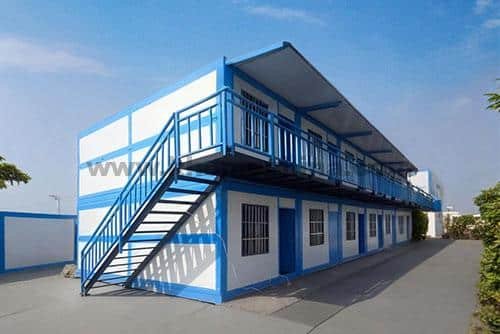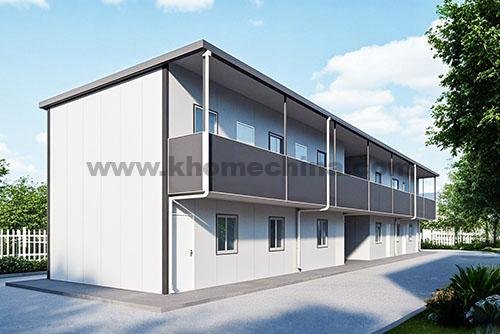construction site accommodation
construction workers accommodation / construction site sleeping accommodation / temporary site accommodation / Construction Site Accommodation Units
In the process of modern urban construction, construction site accommodation is a core facility to protect the basic rights of workers and ensure the efficient operation of projects. As a concrete carrier of the “people-oriented” concept in the construction industry, the construction site living quarters not only need to meet the workers’ daily rest and sleep needs, but also need to achieve rapid deployment and recycling through modular design, while taking into account cost control and environmental friendliness.
At K-HOME, we actively explore innovative models of Construction Site Sleeping Accommodation, striving to create a large-scale replicable worker living solution through the combination of lightweight materials and prefabricated components while ensuring safety. These solutions not only comply with building safety regulations, but are also more efficient and user-friendly.
What is Temporary Accommodation on a Construction Site?
Temporary construction site accommodation refers to accommodation facilities for workers engaged in construction activities. These accommodation facilities are temporary structures, usually of modular design, which can be easily constructed and dismantled.
The construction site accommodation shall include dormitories, dining halls, and sanitary facilities. These facilities should meet the daily needs of workers and comply with health and hygiene standards.
Temporary accommodation facilities demonstrate a commitment to the well-being of workers and create a positive working environment.
prefab Container for site accommodation container accommodation construction site container accommodation prefabricated k house for construction site accommodation prefabricated k house for construction site accommodation prefabricated k house for construction site accommodation prefabricated T house for construction site accommodation prefabricated T house for construction site accommodation prefabricated T house for construction site accommodation
Short-Term Project Flexibility through Temporary Site Accommodation
Temporary site accommodations are a useful option for projects with short timelines or remote locations. These frequently manufactured modular components can be quickly deployed and moved as needed.
Its main features include:
- Portability: Temporary accommodation units can be easily moved to different locations depending on the relocation of the project.
- Cost Effectiveness: Low cost compared to permanent construction.
- Basic amenities include public restrooms, a simple dining area, and single or bunk beds for resting on the construction site.
Construction Site Sleeping Accommodation Requirements
“Getting a solid night’s rest is super important for folks who work with big machines or or do tough physical labor all day—it keeps them sharp, safe, and ready to tackle the job.” Construction site sleeping accommodations should meet the following standards:
- Space Allocation: Minimum 4m² per person (as per UK Building Regulations).
- Heating and cooling: AC provides
- Toilet and shower: Construction site workers must have access to functioning toilets – toilets must be flushable, lockable and equipped with hot and cold water sinks. Contractors and construction site managers must ensure that adequate toilets are provided for workers on site and that they are cleaned and maintained regularly.
- Changing room & Lockable storage: Separate changing rooms for men and women are required, with secure lockers for clothing and valuables.
- Dining Facilities: On-site canteens serving nutritious meals to sustain energy levels.
Different types of construction site accommodation units | support projects of all sizes
K-HOME is the most trusted provider of temporary accommodation in China. We undertake projects of all sizes.
For smaller construction sites, a single on-site accommodation unit can provide a safe and comfortable working base for workers. For larger projects, we can provide an integrated network of units including welfare facilities, dormitories, and on-site offices to create a fully functional on-site community.
Need Help Finding The Right Construction Site Accommodation Solution?
prefabricated containers for site accommodation
We offer a wide range of container site accommodation solutions. Prefabricated containers are one form of this. These containers are part of a replicable modular structure that can be built for any purpose. Whether you need modular dormitories, temporary canteens or on-site offices, the layout and functionality can be adapted to meet specific needs, providing flexibility to meet your requirements.
At the same time, these prefabricated container units are made of sturdy and durable materials that can withstand the challenges of the construction environment.
K-HOME offers prefabricated containers in a variety of forms, the common ones being detachable containers, flat pack containers, and folding containers. Each of these containers has its own advantages and disadvantages, and in actual use, all factors need to be combined to make a choice.
Modular Barracks for site accommodation
The modular barracks refers to a residential area or housing unit built using a modular building method. This means that the barracks are assembled by prefabricated modules or partially. These modules or parts are built in manufacturing places and then transported to the final assembly position required.
K-home offers modular barracks have: T-Type Modular Barracks and K-Type Construction Barracks. These barracks are built in modules T/K. This size is the basic unit for building modular barracks. It can quickly achieve different spatial layouts by combining and splicing multiple wall panels. This standard module size makes the construction process of the barracks more efficient.
T-Type Modular Barracks
K-Type Construction Barracks
How to choose the right prefabricated house for you?
– Options limited by cost:
- K Type house <T Type house < detachable container house < folding container house < flat pack container house
- If your construction only use about 5 years, and no big wind, you can choose K-type house, which is most cost-effective.
- If you need to remove them to other places, you can choose detachable container house, folding container house and flat pack container house, which it is easy to remove by truck.
- If your project is urgent, and want to install quickly, you can choose flat pack container house and folding container house.
– Selection limited by size
T-Type house and detachable container house. If you need special size, you can choose T-type house and detachable container house, which can be customized.
Benefits of Proper Temporary Construction Site Accommodation
1. Improved Worker Productivity
High-quality temporary accommodations directly contribute to optimized workflow efficiency. Workers who work physically demanding jobs or unpredictable shifts experience less fatigue when they have access to cozy sleeping quarters, ergonomic rest rooms, and dependable amenities (such silent zones and heating/cooling systems). Sharper attention, quicker decision-making, and fewer on-site mistakes are all results of this restfulness.
Facilities that boost morale, such communal lounges, recreational spaces, or affordable meal services, can help people feel valued and like they belong. Contented employees are more inclined to cooperate with colleagues, adhere to safety protocols, and do consistent work. For instance, companies that invest in modular living units with natural lighting report 15–20% productivity gains compared to cramped, basic trailers.
2. Enhanced Health and Well-being
Construction sites in remote or isolated areas often strain workers’ mental health due to social isolation, long commutes, or limited access to resources. Purpose-built accommodations can mitigate these risks by incorporating:
Mental health support systems: On-site counseling spaces, digital connectivity for family communication, and mindfulness zones.
Community-building initiatives: Shared kitchens, sports facilities, or skill-sharing workshops to encourage interaction.
Stringent hygiene standards are equally critical. Modular bathrooms with touchless faucets and soap dispensers, plus daily cleaning routines and on-site laundry services, help stop germs from spreading. This keeps everyone healthy and prevents whole work crews from getting sidelined by sick days. And in places with scorching summers or freezing winters, dorms with proper heating and AC mean workers don’t risk heatstroke or frostbite. They’ll show up ready to work safely every morning instead of calling in sick.
3. Cost and Time Efficiency
Traditional housing construction—involving brick-and-mortar builds or lengthy leases—consumes valuable project budgets and schedules. Pre-engineered temporary units, by contrast, offer:
Rapid deployment: Modular pods or containerized rooms can be assembled in days, not months, using cranes and minimal labor.
Scalability: Facilities expand or contract based on project phases, avoiding over-investment in unused space.
Frequently Asked Questions
SEND A MESSAGE














